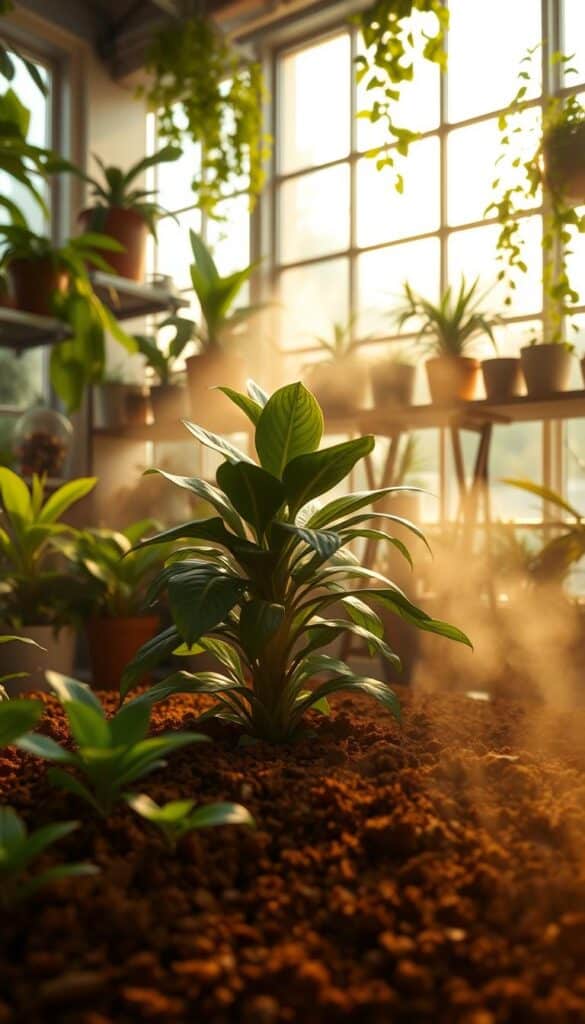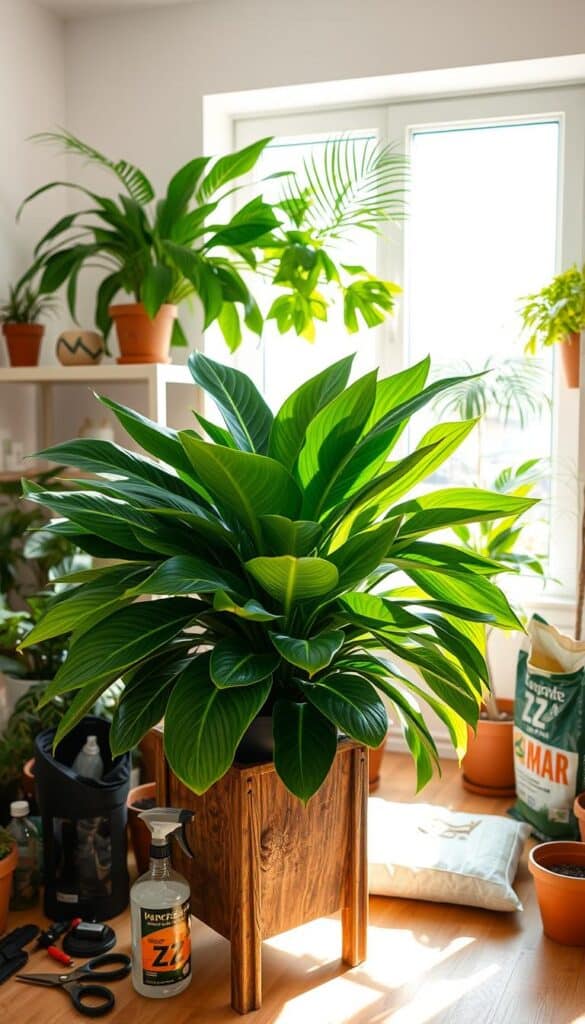Welcome to my ZZ Plant Jungle Warrior care guide! If you’re here, you’re probably ready to dive into the world of low-maintenance, high-reward houseplants. I still remember my first encounter with this resilient beauty—its glossy leaves and ability to thrive in conditions that would make other plants wilt. It was love at first sight, and since then, I’ve learned how to give it the best care possible.
Originating from Eastern Africa, the ZZ Plant is known for its drought-resistant rhizomes and air-purifying qualities. It’s almost indestructible, making it perfect for both beginners and seasoned plant enthusiasts. Whether you’re looking to improve your space’s aesthetics or purify the air, this plant delivers.
In this guide, I’ll share everything I’ve learned about proper watering, the best soil mixes, and ideal lighting conditions. You’ll also get step-by-step instructions and maintenance tips to help your plant thrive. From setting up the right environment to troubleshooting common issues, I’ve got you covered. Let’s get started on this journey to becoming a plant care pro!
Understanding My ZZ Plant Jungle Warrior
My ZZ Plant Jungle Warrior, scientifically known as Zamioculcas zamiifolia, hails from the tropical regions of Eastern Africa. This remarkable houseplant has evolved to thrive in challenging conditions, making it a perfect choice for indoor spaces. Its semi-succulent nature allows it to store water in its rhizomes, enabling it to survive droughts with ease.
Origins and Unique Qualities
The plant’s origins in Africa have gifted it with adaptations that make it ideal for low-light environments, such as offices. Its shiny, oval leaves not only add aesthetic value but also contribute to its ability to purify the air. The rhizomatous growth habit ensures it stays healthy even with minimal care.
Why I Love This Resilient Houseplant
I adore my ZZ Plant for its resilience and unique appearance. Watching its leaves transform from bright lime to deep emerald green is a delight. Its low-maintenance requirements make it perfect for busy lifestyles, ensuring it thrives even with infrequent watering.
Creating the Optimal Environment: Soil, Light, Humidity, and Temperature
Setting up the right environment is key to helping your ZZ Plant thrive. Let’s break down the essential elements you need to get just right.
Choosing the Right Soil Mix
The soil mix is crucial for proper drainage. I recommend using a mix of 2 parts all-purpose soil, 1 part perlite, and 1 part sand. This blend ensures water drains well, preventing root rot. Perlite adds air pockets, while sand improves drainage. Avoid using regular potting soil alone, as it can retain too much water.
Finding the Perfect Light and Humidity
Your plant prefers bright, indirect light. Direct afternoon sun can scorch the leaves, so east- or west-facing windows are ideal. Humidity-wise, average indoor levels (around 40-50%) work well. If your space is particularly dry, consider using a mister or humidifier.
Maintaining the Ideal Temperature
Keep your plant in an area with consistent temperatures between 65°F-85°F. Avoid placing it near drafty windows or extreme heat sources. Consistent temperatures promote healthy growth and prevent stress.
| Factor | Recommendation | Importance |
|---|---|---|
| Soil Mix | 2 parts all-purpose + 1 part perlite + 1 part sand | Ensures drainage and aeration |
| Lighting | Bright, indirect light | Prevents leaf scorch |
| Humidity | 40-50% indoor humidity | Maintains leaf health |
| Temperature | 65°F-85°F | Supports steady growth |
By following these guidelines, you’ll create an environment where your plant can flourish. Proper drainage, light, humidity, and temperature are the pillars of successful plant care.

zz plant jungle warrior care guide: Step-by-Step How-To Instructions
Now that we’ve covered the basics, let’s dive into the hands-on process of setting up your plant for long-term success. Proper potting and placement are crucial, and I’m excited to share my proven methods with you.
Setting Up for Success: From Pot to Placement
Start by gently removing your plant from its old pot. This is the perfect time to inspect the roots and ensure they’re healthy. If the roots are tightly packed, use your fingers or a blunt tool to loosen them slightly. This helps the plant settle into its new environment.
Next, prepare your new pot. I recommend using a terracotta or self-watering planter with excellent drainage holes. Add a layer of fresh soil mix at the bottom to provide a sturdy base. Place the plant in the center, ensuring the base of the stems sits just above the soil surface.
Fill in the sides with more soil, gently firming it around the roots to secure the plant. Avoid packing the soil too tightly, as this can prevent proper drainage. Water lightly to settle the soil, and voilà! Your plant is ready for its new home.
Essential Tools and Accessories
For maintaining your plant, I swear by a few key tools. A soil moisture meter is invaluable for checking water levels without guesswork. Terracotta pots are my go-to for their natural breathability, and self-watering planters are perfect for busy schedules.
Remember, the right setup is just the beginning. Regular maintenance, like checking soil moisture and providing bright, indirect light, will keep your plant thriving all season long. By following these steps, you’ll be well on your way to nurturing a happy, healthy plant that brings joy to your space.

Mastering Watering, Fertilizing, and Daily Maintenance
Watering and fertilizing are where many plant owners stumble, but with the right approach, it’s easier than you think! I’ve learned through experience how to keep my ZZ Plant happy and thriving.
When and How to Water Effectively
I check the soil moisture by sticking my finger into the soil about an inch deep. If it feels dry, it’s time to water. I usually wait 2-4 weeks between waterings. Overwatering is a common mistake, so I always err on the side of caution.
- Top-watering: I gently pour water over the soil until it drains out the bottom.
- Bottom-watering: I place the pot in a saucer of water and let it soak for about 10 minutes.
Both methods keep the soil evenly moist without waterlogging the roots.
Fertilizer Tips to Encourage Growth
Fertilizing is simple. During spring and summer, I use a half-strength liquid fertilizer. I dilute it with water as directed on the label to avoid burning the roots. In fall and winter, I skip fertilizing since the plant is dormant.
Daily observation is key. I look for yellowing leaves, which can signal overwatering, and droopy leaves, which might mean it’s time to water. It’s all about finding that balance—just enough care without overdoing it. With these tips, your ZZ Plant will be a stunning addition to your space.
Propagation, Repotting, and Growth Expectations
Once your ZZ Plant is thriving, you might want to share its beauty by propagating it or give it more room by repotting. Let’s explore how to do both successfully and what to expect as your plant grows.
Simple Propagation Techniques
I’ve found two effective ways to propagate my ZZ Plant: division and water propagation. Division involves gently separating the rhizome, ensuring each section has healthy roots. Water propagation is as simple as placing a leaf cutting in a clear container and waiting for roots to develop. Both methods are straightforward and require minimal effort.
Repotting: When and How to Do It
Repot your plant when the roots become crowded or if the soil retains too much water. Choose a pot slightly larger than the current one to give the roots room to grow. Gently separate the rhizome, taking care not to damage the roots. This process minimizes stress and helps the plant adapt quickly to its new environment.
| Propagation Method | Description | Success Rate |
|---|---|---|
| Division | Separating the rhizome into sections with healthy roots. | High |
| Water Propagation | Placing leaf cuttings in water to develop roots. | Moderate |
| Repotting | Transferring the plant to a larger pot for more space. | High |
Growth expectations for your ZZ Plant are modest, as it develops new stems gradually. With proper maintenance, your plant will remain healthy and continue to grow steadily over time.
Handling Common Issues: Pests, Overwatering, and Leaf Drop
Even the hardiest houseplants can face challenges. Let’s tackle some common issues head-on and explore how to resolve them effectively.
Identifying and Resolving Troublesome Signs
One of the first signs of trouble is droopy leaves. If your plant’s leaves start to droop, it might be time to check the soil moisture. I use a soil probe to get an accurate reading. If the soil feels dry, watering is overdue. On the other hand, yellowing leaves often indicate overwatering. I’ve learned to wait a week or two before watering again to allow the soil to dry out properly.
Pests can also be a problem. Aphids and spider mites are common culprits. I inspect the leaves regularly and use insecticidal soap or neem oil to treat infestations. It’s important to act quickly to prevent the problem from spreading.
Root health is another critical factor. If you suspect root rot due to overwatering, gently remove the plant from its pot and inspect the roots. Healthy roots are firm and white, while rotting roots are soft and mushy. Prune any damaged roots and repot the plant in fresh, well-draining soil.
Regular checks are essential. I recommend inspecting your plant weekly and adjusting your care routine as needed. A monthly deep inspection can help catch issues before they become severe. By staying vigilant and taking prompt action, you can keep your plant thriving and avoid common pitfalls.
My Final Thoughts on Nurturing a Thriving ZZ Plant
Reflecting on my journey with the ZZ Plant Jungle Warrior, I am reminded of the rewarding experience of nurturing a low-maintenance yet resilient houseplant. This plant has taught me valuable lessons about patience, adaptability, and the joy of watching something thrive under my care.
Consistency is key, especially when it comes to water and soil conditions. Even during the quieter winter months, regular checks ensure the plant stays healthy. I’ve learned to adapt my care routine with the changing seasons—embracing the renewed growth of spring while exercising caution in the heat of summer.
Every plant is unique, and understanding its size and root system helps tailor care. Whether it’s adjusting the frequency of watering or the amount of water given, it’s all about finding the right balance. This attention to detail ensures your space remains a beautiful haven, benefiting from proper light, air, and humidity.
Consider this guide as a living document, evolving as you gain more experience. I encourage you to share your journey, join our community, and continue learning together. With consistent care and attention, your ZZ Plant will not only thrive but also enhance your home’s atmosphere, bringing joy and freshness to your space.
